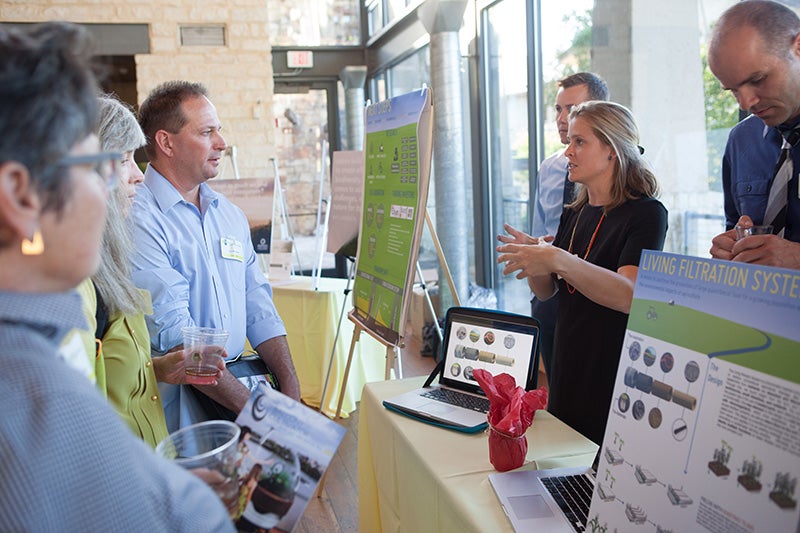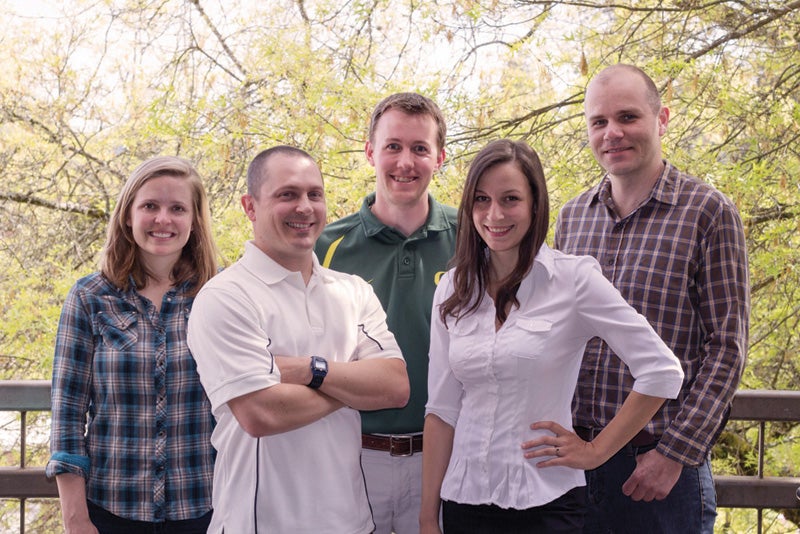A University of Oregon landscape architecture student team defeated professional competitors to take first prize in a global innovation challenge to improve the food system, winning $10,000 and advancement to a prototype round. The team now will be provided business incubation support and an opportunity to win $100,000 and move their design to production.
The UO team’s design, which would help farmers retain nutrients in soil while decreasing fertilizer use, was based in part on the earthworm’s digestive system and would improve soil health over time.

Above: Alison Lewis (right) explains the University of Oregon team’s project to attendees Colleen Mahoney, Cheryl Spector, and AJ Wacaser at the awards event in the Wildflower Center gallery in Austin, Texas. Flanking Lewis are her A&AA teammates Wade Hanson (on Lewis’ right) and Krisztian Megyeri (on Lewis’ left). Photograph courtesy Chris Carson Photography.
The Biomimicry Global Design Challenge, developed by the Biomimicry Institute and sponsored by the Ray C. Anderson Foundation, asked participants to tackle any aspect of the food system—such as waste, packaging, agricultural pest management, food distribution, and energy use—that could be improved by looking to nature for design guidance. Winners were announced at an awards ceremony October 4 at the Lady Bird Johnson Wildflower Center in Austin, Texas, where the team’s presentation to judges and potential funders helped to tip the scale in their favor.
The goal of the UO team’s project, “Penthouse Protozoa: Living Filtration System,” was to filter water draining from farm fields so it’s safer for downstream environments. The team’s “biomimetic drainage system” would retain nutrients in soil so water is absorbed by plants rather than leaving the field as runoff polluted by fertilizers and other chemicals.
The team members are Wade Hanson, Casey Howard, Matt Jorgensen, Alison Lewis, and Krisztian Megyeri. All but Howard, the team captain and an undergraduate student, are graduate students, and all were in a spring 2015 class taught by Instructors Anne Godfrey and Emma Froh.
The eight finalist teams have been invited to prototype their solutions in an accelerator program that will award $100,000 to the top contender in an effort to increase speed-to-market for biomimetic solutions to global problems.
Godfrey chose the competition for her design studio “because it’s systems-based learning and systems-based designing. At first blush many people thought, Is this really landscape architecture? But when you think about it, landscape architecture is about understanding the large-scale system in which you will be designing.”
The competition also “represents the next place we’re going in practice,” she added, “not only with the biomimicry piece but also connecting with individuals both within and outside environmental design. A competition like this really prepares students for professional practice. Aspects [of business] that often take place later on in people’s careers, such as that investor or developer piece, get brought front and center so they can learn about that. It’s a thing we normally don’t talk about, but it’s crucial.”
Godfrey is now working to connect the UO team with mentors for the next step of the challenge. “This is all new to them and in many ways it’s new to me, so I’ve connected with RAIN,“ the Eugene-based Regional Accelerator and Innovation Network. Godfrey is also collaborating with other A&AA faculty members with relevant research background and connections to help the student team develop networking opportunities.
“This is A&AA and the Department of Landscape Architecture at our best: expansive and systems-based thinking, a commitment to pressing environmental and social issues, and the highest level of creativity and execution,” said Brook Muller, interim dean of A&AA.
“We are so happy for Wade, Casey, Matt, Alison, and Krisztian, and so appreciative of the efforts of Instructors Anne Godfrey and Emma Froh,” Muller said. “Their dedication to our students and to facilitating a richly rewarding design studio experience is extraordinary.”

Above: UO landscape architecture students (from left) Alison Lewis, Matt Jorgensen, Wade Hanson, Casey Howard, and Krisztian Megyeri won first prize in the Biomimicry Challenge.
The second prize in the open challenge (open to both students and professionals) was awarded to a team from Thailand, while a team from Chile won third prize. In the student-only competition, first prize went to a team from the University of Calgary in Canada, second prize to a team from the University of California, Long Beach, and third prize to a team from Wageningen University in the Netherlands. View the pitch videos for all finalists.
“We are thrilled to be supporting these eight teams from around the world as they continue to develop and prototype their concepts,” said Megan Schuknecht, director of design challenges at the Biomimicry Institute. “Over the next year, we will be providing them with access to business training, resources and mentors, with the ultimate goal of helping to bring these biomimetic innovations to market.”
The Ray C. Anderson Foundation has pledged $1.5 million over four years to support the Biomimicry Global Design Challenge, a multi-year effort to crowdsource, support, and seed promising innovations inspired by nature. Each year beginning in 2016, the Institute and Foundation together will award the $100,000 “Ray of Hope” Prize to the most viable prototype that embodies the radical sustainability principles of biomimicry. The first two years are focused on food systems, while subsequent years will change to other sustainability issues.
